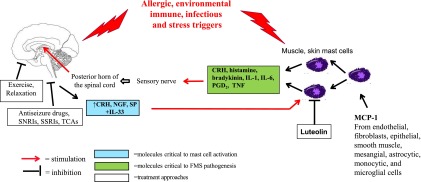Fig. 1.

Diagram representation of the proposed steps involved in the pathogenesis of FMS and targets for treatment. Stress peptides (CRH, nerve growth factor, neurotensin, SP) are released from the spinal cord in peripheral tissues (blood vessels, muscles, skin) in response to allergic, environmental, immune, infectious, and stress triggers (blue box). There, they act synergistically with IL-33 to stimulate mast cells, which secrete inflammatory and neurosensitizing molecules such asCRH, histamine, bradykinin, IL-1, IL-6, prostaglandin D2, and TNF (green box). These molecules can either activate peripheral sensory nerves directly or reach the brain through the systemic circulation, thus creating a self-sustaining pain circuit. Treatment approaches (white box) include exercise and relaxation to reduce stress (specific norepinephrine reuptake inhibitors (SNRIs); specific serotonin reuptake inhibitors (SSRIs); tricyclic antidepressants (TCAs) to reduce anxiety and depression; as well as TCAs and antiseizure medications to provide analgesia. Finally, luteolin and related compounds can inhibit the release of MC mediators.
